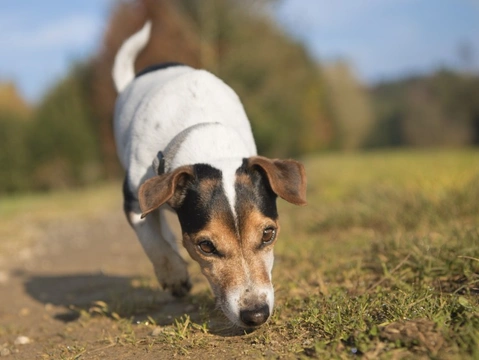
Honing your dog’s sense of smell
The dog’s most powerful sense is their sense of smell, and they have millions of scent receptors in their noses, leaving us humans lagging behind by some distance! Certain breeds of dogs too have much more highly tuned senses of smell than others-with the breed that has the very best scenting ability of all being the Bloodhound. However, whether you own a breed of dog that is widely prized for their scenting ability such as the German shepherd, or a small lapdog or a mixed breed, your dog’s sense of smell is very acute, and you might well be surprised at what they can do with it!
Dogs do of course use their sense of smell all the time-sniffing when out on walks, as greeting, and any time the treat jar is opened-and it can be both fascinating and fun to find out exactly what your dog can do when it comes to scenting, and teach them a few ways to hone their abilities.
In this article, we will share some different games and methods that you can use to help to hone your dog’s sense of smell, or rather, give them the chance to really show off what they can do! Read on to learn more.
The basics
Everything in the world has a scent-some are of course stronger than others, and items will also take on the scents of the things around them too. Your dog can discern between millions of different individual scents, even in adverse situations, and honing your dog’s sense of smell is less about improving their sense of smell, but more getting them to use it in a certain way, and in a way that you can interpret and direct.
When you get started, it is a good idea to use a high value treat for your dog to use as their target, both to keep them interested, and because such treats are very fragrant to dogs, and so, easy to pick out from background smells. Additionally, it is a good idea to use a dry treat rather than say, moist chunks or oily treats such as pig’s ears, as dry treats do not transfer their smell to their surroundings as strongly, making things a little easier for your dog.
Simple scenting games
When you get started, the aim is more to show your dog what you want them to do, rather than improve their scenting ability. Choose a command that you will use in future to tell your dog that you want them to sniff something out, and then simply hide a treat in one clenched fist and nothing in the other, hold them both out to your dog, give the command, and wait for them to pick the correct hand.
Moving on from this, hide a treat somewhere within the room that your dog can get to but not see, and begin by repeating the treat in the hand game above. Then, immediately give your dog the seeking command, and encourage them to sniff around the room until they find the second hidden treat.
When your dog is competent at this, you can carry on without beginning with the treat in the hand first.
Expanding your dog’s ability
The next step when your dog can reliably hunt out a treat when commanded to do so is to teach your dog to scent out different things and to follow a scent cue until they find it.
For instance, pick a favourite toy that your dog spends a lot of time with, and handle it and play with it until your hands have picked up the scent of it, and your dog has seen and smelt you doing so.
Then, hide the toy out of sight, let your dog sniff your hands, and command them to seek it out.
This forms the basis of teaching your dog to sniff out things from scent memory, which is the same way in which professional sniffer dogs and search and rescue dogs work!
Next, offer them a worn item of clothing to smell, and encourage them to seek out the person it belongs to. Your dog should also be praised and rewarded when they are working along the right lines, such as heading for that person’s favourite chair or bed!
It is wise to get the basics down within the home, when there are only familiar scents around, and not too much going on that will divert your dog’s attention.
When your dog is familiar with the cue command that you give to them, you can begin to work outside, over greater distances, and using items that your dog may not have come across before. The more stimulus there is around in terms of other scents and greater distances, the more challenging it will be for your dog-but all dogs are capable of doing this, if you just put in the time and work!



